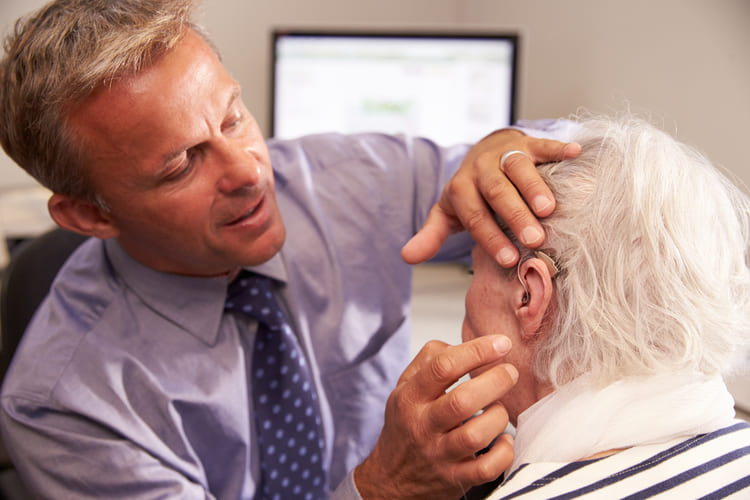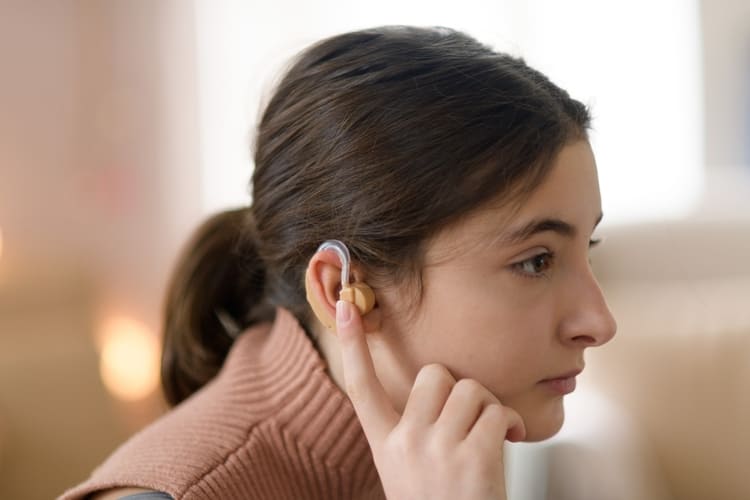Jasmine Birtles
Your money-making expert. Financial journalist, TV and radio personality.

How to boost your listening skills – and save thousands of pounds on hearing aids
One in four Britons are expected to suffer from hearing loss by the year 2030, according to recent research by Lindus Health.
Even more worryingly, a third of those affected by hearing loss are under-50, with the problem blamed, in part, on the popularity of earphones, and listening to loud music.
Sadly, such hearing loss is currently irreversible, but there are some things you can do to try to help improve your hearing naturally, from better ear hygiene to training your brain to better pick out certain pitches you’re struggling to hear.
Many people with hearing loss can find a visit to a cafe or bar “noisier” and more uncomfortable on their ears than someone who doesn’t suffer from hearing loss.
The reason for this is because most hearing loss is associated with difficulty hearing certain pitches rather than a general issue with volume.
Hearing aids try to address this imbalance by amplifying those pitches, so the wearer, for instance, can hear the dialogue on the TV without having to have the volume deafeningly loud.
Interestingly, a team of doctors and biomedical engineers have created a new app called eargym to help improve your hearing in much the same way: by training your brain to better pick out those more difficult-to-hear pitches.
As eargym’s website notes: “One of the first signs of hearing loss is a difficulty to understand what is being said. We can still hear the conversations around us but it becomes harder to apply meaning to what we hear.
“Both selective attention and working memory are linked to speech perception. By practising these skills with auditory exercises, we can start to train our brains to better understand conversations in challenging listening environments.”
The app, which costs £9.99 and was funded by the Alzheimer’s Society and UK Research and Innovation (UKRI), is full of fun little games that sees, for example, the user adopt the role of a waiter trying to fulfil orders in a noisy cafe. In that game, they must try to make out what is being said over the general background din and the frothing of the cappuccino machine.
Incredibly, 83 per cent of the app’s users said playing the games improved their hearing skills, while 68 per cent said the games improved their ability to hear in noisy places (like a cafe) in just seven weeks.
On average, participants’ hearing improved by “two decibels”, which equates to “a 20% improvement in speech intelligibility in everyday life”.
You’ve got to be fairly tech savvy and have good dexterity to use the app – which is a lot of fun to play.
If you are not able to use the app, there may be other things you can do to try to ward off the need for a hearing aid for a little bit longer, including simple things like better ear hygiene.

There’s a chance your recent hearing loss could be caused by something as simple as a wax build-up.
A whopping 2.3 million people in the UK have problems with earwax that are sufficient to warrant intervention, according to the National Institute for Health and Care Research (NIHR). The issue is a particular problem in care homes, where 44 per cent of residents with dementia were found to have blocked ears.
Hearing loss is the single most modifiable risk factor for the prevention of dementia, and is associated with a number of other health conditions, from depression to balance issues, so it’s important to keep on top of any earwax build-up.
NIHR stats show that 80 per cent of people with blocked ears reported an immediate improvement in their hearing following treatment. Yet despite earwax being a major cause of preventable hearing loss, it’s increasingly difficult to get relief these days.
Most doctors, for instance, refuse to treat patients for wax build-up any more, as Lincolnshire nurse Helen Stewart discovered. “Working as a registered nurse within a care home setting, I became increasingly aware that we had several residents with excessive wax in their ears which was causing hearing loss and, in some cases, discomfort.
“We were instilling ear drops into these residents’ ears with little effect and were unable to get the GP surgery to come and remove the wax as they previously would have. Where the resident was registered with a GP that still offered the service, there was often several months wait for someone to come out to perform the procedure.”
The experience spurred Helen to launch a mobile earwax removal service using the latest micro-suction technology in May this year. Her company, Lincoln Ear Health, charges up to £65 for the 30-minute, at-home treatment, with the rate discounted for group bookings.
The procedure is performed using a microscope with depth perception.
Unlike traditional earwax removal options, such as syringing (which carries a risk of infection and the bursting of eardrums), micro-suction is pain-free and has immediate results.
As Stewart notes: “Many clients have commented how much better they can hear straight away and that were happier because of this as they were able to communicate/take part in activities/even watch TV/listen to the radio which they had struggled to do previous to the wax removal.”
The service is not unique to Lincoln Ear Health. There are similar private practices offering at-home micro-suction across the UK. If you are able to leave your home, Specsavers also offers a similar micro-suction service at some of its high street stores, from £55.
Sadly, not all hearing loss can be put down to earwax alone. And, if you find you’re struggling to hear friends in a busy cafe, or are having to increase the TV volume to make out what is being said, you probably ought to book yourself a hearing test, just to be sure.
You can book free hearing tests at Boots, Specsavers and many other high street clinics. Alternatively, you can always test your hearing from home, using Boots’ free, online hearing test.
If it transpires that you do need a hearing aid, you may find yourself bamboozled by the sheer volume of different types and models there are to choose from.
There are lots of different styles of hearing aids, from the classic “over-the-ear” hearing aid you’ve probably spotted discarded on the pavement (they’re notoriously easy to lose), to the various “invisible” or “near invisible” hearing aids, like the “in-the-ear” options (which look a bit like one of those earpieces spies use in Hollywood films). Another popular option is the “completely-in-the-canal” hearing aid, which is moulded to fit inside the ear canal itself.
Each type has its positives and negatives. For example, “completely-in-the-canal” hearing aids are often the least visible and pick up the least amount of wind noise, but, on the flipside, are most likely to get blocked by wax.
For an idea of the various styles of hearing aids, see this useful explainer.
Beyond just the look and fit, there are many other issues to consider before deciding which style is best for you.
More expensive hearing aids have features like Bluetooth connectivity, meaning you can channel the sound from your phone/TV directly into your ear, which cuts out a lot of the interference. The downside to this, however, is that it makes speaking to other people while watching the TV almost impossible, as you will struggle to hear them over the TV noise being pumped directly into your ear canal.
The other advantage or disadvantage to more-expensive models (depending on your take) is that you control your hearing aid using your phone, rather than having to fiddle about in your ear to adjust the volume.

Crucially, the main difference between the hearing aids that are sold on the high street and the ones offered free on the NHS is aesthetics. NHS hearing aids are, in the main, still the old fashioned “over-the-ear” types rather than the so-called “invisible” hearing aids you’d find at Boots, Scrivens, Specsavers and other independent stores.
Indeed, one of our team, who wears an NHS hearing aid, tried several of Specsavers’ invisible hearing aids and found they were no better at amplifying the sounds that he struggles to hear.
His experience doesn’t surprise Gemma*, an NHS audiologist, who didn’t wish to use her real name. She told MoneyMagpie that NHS hearing aids use “the exact same” basic technology as those sold by high street retailers.
She said that the NHS hearing aids are “frequency specific” just like the private aids, and the technology used in the NHS hearing aids “has come on in leaps and bounds over the years”.
“Many patients don’t go private because they wish to get a better sound but mainly for cosmetic reasons as there is more choice of styles in the private sector,” she added.
“Equivalents to the hearing aids we fit would cost around £1,000 each if bought on the high street so they’re pretty advanced to be honest and we get great feedback from patients, some of whom own private aids as well.”
Despite advances in the technology used by the NHS, their hearing aids are not for everyone.
According to the consumer group Which?, those with private hearing aids were considerably more likely to report being “satisfied” with their device, than those using a NHS hearing aid, with the figures standing at 77 per cent and 34 per cent respectively.
The Which? survey focused more on the practicalities of the devices themselves (ie. maintenance and wax build-up) rather than sound quality.
The survey of more than 2,000 hearing aid users saw Widex’s hearing aid rank the highest, with a 91 per cent satisfaction rating. (Widex’s hearing aids are relatively “cheap”, starting from £790 a pair.)
Starkey hearing aids (which are sold Boots, Hidden Hearing and Scrivens) came in second, with a customer satisfaction score of 85 per cent.
They were closely followed by Phonak, ReSound, Amplification and Specsavers Advance, which were all a percentage point or three lower than the second spot.
Disposable batteries will cost around £3 a month, so it might be worth paying a little extra for a rechargeable alternative depending on whether you want the “faff” or not of having to then charge them up.
The best hearing aid for you may also depend on the type of lifestyle you live.
Specsavers, for instance, sells 19 different types of hearing aids, which not only vary wildly in price (ranging from £495 a pair to £2,895) but also in the number of bells and whistles they feature, and who they are and aren’t suitable for, too.
Many of the 19, for instance, are not recommended by Specsavers if you lead an “active life”, others are more suitable in noisy, social settings than other hearing aids, which may or may not be more expensive.
Its cheapest pair to receive five stars out of five cost £1,995 – which is nearly a grand less than other similarly top-rated pairs. Again, the extra £1,000 buys more bells and whistles, which you may not want or need, so it’s really a case of drawing up a list of exactly what you do and don’t need, and then deciding how much you’re willing to spend to get all those must-haves.
